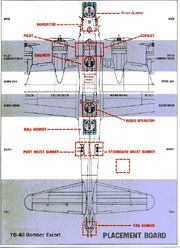The YB-40 Flying Fortress was an experimental adaptation of the B-17F Flying Fortress designed to act as a bomber escort for the B-17 formations attacking Germany during World War II.
Description[]
The total armament of the YB-40 was reportedly as high as thirty automatic weapons of various calibers, ranging from 12.7 mm to 20 mm and even 40mm cannon in hand held installations in the waist, with additional power operated turrets above and below the fuselage. Several reports indicated installation of power operated turrets in the extreme nose and tail, each containing four 12.7mm guns. The YB-40 weighed 28,803.1 kg and achieved 458.6 km/h.[1] The YB-40 also had a crew of 9 and the maximum range was 3637.1 km.
History[]
Prototype[]
The escort bomber concept was first developed in 1943, with a Boeing built B-17F (41-24341) being converted into the XB-40 bomber escort by Lockhead-Vega. It had several modifications made to the original B-17, such as additional armor, and the bomb bays served as ammunition containers, with the normal quantity being increased by more than 50%. A power operated turret, with two additional 12.7mm machine guns, was installed in the roof aft of the radio compartment, from where it was controlled. Twin 12.7mm guns replaced the single guns in the waist positions, and a twin gun turret - similar to that later fitted as standard to B-17Gs - was fitted to the nose.[1]

Placement board showing positions and armament.
Following on from the XB-40, Lockheed-Vega built 20 converted B-17Fs (YB-40s) to further evaluate the concept, which saw brief operational service in mid 1943. The armament of the YB-40 was considerably heavier that that of the XB-40.
Operations[]
The first Eighth Air Force sortie with YB-40 escort was undertaken in May 1943 against St. Nazaire. Later missions proved that YB-40s were incapable of keeping up with normal B-17Fs in climb and combat cruise and, by August 1943, they were recognized as a failure, with the remaining aircraft being reconverted as bombers or used as gunnery trainers in the US. In total, the YB-40 had 48 sorties and were not used past 1943 in any US squadron.
Media[]
At least two examples are shown in the scrapyard scene near the end of the 1946 film The Best Years of Our Lives.[2] As the single most famous bomber of the second world war, besides possibly the British Lancaster, it has appeared in numerous films and TV shows about WWII, it's recognizable long body and four engines a sign of hope for the trapped/ surrounded/ pinned down Americans, British, etc. soldiers.
References[]
- ↑ 1.0 1.1 Green, William. Famous Bombers of the Second World War. Purnell Book Services. 1975. Page 56.
- ↑ http://impdb.org/index.php?title=The_Best_Years_of_Our_Lives
| |||||||||||||||||||||||
